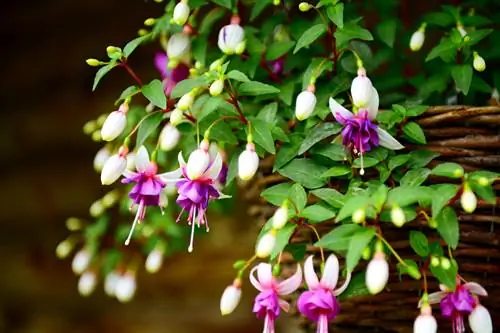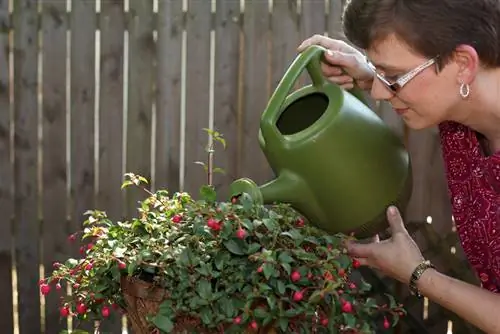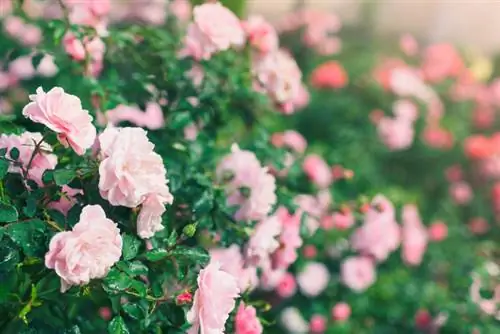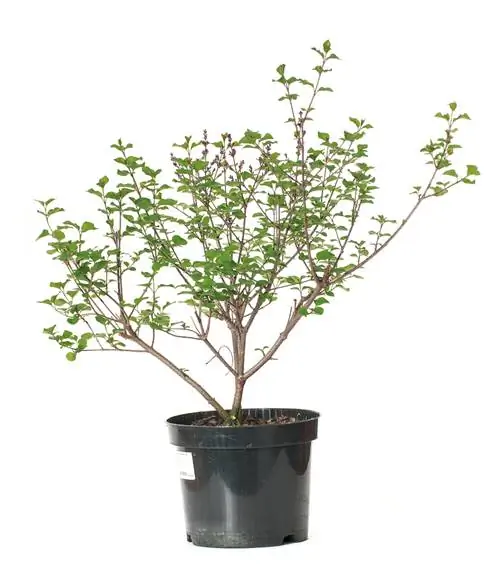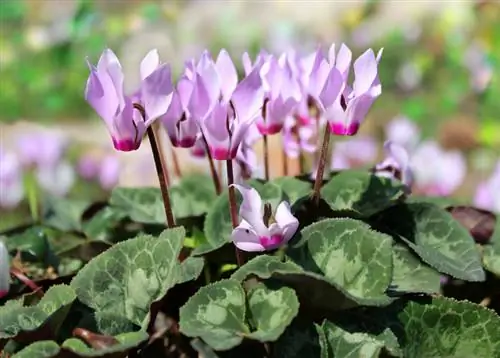- Author admin [email protected].
- Public 2023-12-25 17:45.
- Last modified 2025-01-23 11:20.
Some of the most beautiful fuchsias are sufficiently hardy to set picturesque accents as ornamental plants in the garden. Creative gardeners have been using this fact for generations to transform the partially shaded edge of trees or balconies into a tropical sea of flowers. The following answers to frequently asked questions explain in detail how the classic feels comfortable and thrives in your green kingdom.

When does a fuchsia bloom and how do you care for it?
Fuchsia is an ornamental plant that blooms from June to October in various colors such as white, red, pink, purple, violet and blue. It prefers partially shaded locations, nutrient-rich and well-drained soil and even soil moisture. Care includes regular watering, fertilizing and cleaning out wilted flowers.
Planting fuchsia correctly
From the beginning/mid of May, sunny to semi-shady, humid locations in the garden should be reserved for the fuchsia. Dig hollows about 20 cm deep in the fresh, well-drained and nutrient-rich soil. Plant the plants deep enough so that the soil initially reaches the lower pairs of leaves. As the season progresses, pile up the compost-enriched soil in proportion to the progress of growth. This measure makes an important contribution to he althy and undamaged wintering.
Care tips
The professional fuchsia care program is based on a well-balanced package of measures. We have compiled all relevant key points for you in the following overview:
- Ensure uniform soil moisture without causing waterlogging
- If the air is dry, spray with lime-free water in the morning or evening
- Fertilize weekly from April to September with compost or liquid fertilizer
- Consistently clean out wilted and faded things
- Bridge a summer flowering break with light pruning
- Pile outdoor fuchsias thickly with leaves before winter; Add additional needle sticks
- Shaping and maintenance pruning in early spring without cutting into old wood
Cultivated in planters, Fuchsia move to semi-dark winter quarters in October/November. All wilted flowers and yellowed leaves are removed beforehand. At a cool 10-12 degrees Celsius, water every now and then to prevent the root ball from drying out.
Which location is suitable?
The fuchsia thrives he althily and blooms in a sunny to partially shaded location. Choose a warm, wind-protected location without cold drafts. The tropical flower beauty also does not tolerate blazing sun or summer heat and reacts angrily by refusing to bloom.read more
What soil does the plant need?
The fuchsia does its best in humus-rich, well-drained and nutrient-rich soil. This is even more true in fresh, moist soil that is not threatened by waterlogging. For cultivation in pots and flower boxes, we recommend a mix of garden soil, compost and sand in equal parts. Alternatively, a high-quality and structurally stable pot plant soil with a low peat content.
What is the best time to plant?
So that the partially hardy garden fuchsia can fully establish itself in the bed before winter, we recommend spring planting (€8.00 at Amazon). Plant the young perennials in the ground from the beginning/mid of May at the earliest, provided there is no longer any risk of delayed ground frosts.
When is flowering time?
The fuchsia develops its striking flowers with the long tube and the elegant, often different colored petals and sepals from June to October. The flower impresses with a wide range of colors in white, red, pink, purple, violet and blue. Fuchsias sometimes take a break from blooming in the middle of summer. Don't let this confuse you. Simply cut shoots that are too long back to the first vital bud. In no time the blossom festival continues.read more
Cut fuchsia correctly
A well-considered cut at the right time makes an important contribution to vitality and flowering. How to cut the fuchsia correctly:
- Prop every 2-3 weeks in April and May for richly branched growth
- Clean up wilted flowers regularly
- In the event of a summer flowering break, shorten branches that are too long until they reach the first he althy bud
- Thin out in January and cut back the shoots by a third; If possible, not into old wood
Fuchsias in the pot should be cut back a little before putting them away by removing all withered flowers and yellowed foliage. It is only in early spring that the subshrub receives its shape cut and is thoroughly thinned out. Every branch should start the new season with at least 2 buds.read more
Watering fuchsia
An even soil moisture in combination with high air humidity motivates all Fuchsia species and varieties to achieve top floral performance. Therefore, do not allow the root ball to dry out at any time. Once the surface has dried, water moderately without causing waterlogging. Additionally, pamper the tropical ornamental plant with a shower of lime-free water in the early morning or in the evening.
Fertilize fuchsia properly
Weekly doses of fertilizer are one of the mainstays of a professional care program. From April to September, lightly work the mature compost into the soil in the bed and then water again. Apply a commercially available liquid fertilizer for flowering plants to the pot and balcony box every 8-10 days.
Wintering
The winter protection of garden fuchsias begins with planting by planting the root balls in a small depression and a little deeper than in the nursery pot. In proportion to growth, the small hollow is filled with substrate over the course of the summer. If winter is just around the corner, take these precautions in the bed for a he althy winter:
- Pile the root disc 20-30 cm high with leaves, straw and brushwood
- Place spruce branches around the crowns to protect against icy winds
- Only make a topiary cut in February/March and thin it out thoroughly
In pot cultivation or in the balcony box, put the fuchsias away as late as possible, because light frosts down to -3 degrees Celsius are tolerated and harden the plant. Remove all withered flowers and yellowed foliage with light pruning. The fuchsia hibernates in a slightly darkened room at 10-12 degrees Celsius. Water only a little so that the root ball does not dry out. Fertilization is not carried out during wintering. In March, the subshrub receives its central shape cut and is carefully cleaned of dead wood, stunted shoots and inward-facing branches.read more
Propagate fuchsia
Both hobby gardeners and professional gardeners favor the cutting method for propagating fuchsias. To do this, cut off non-flowering shoots that are 10-15 cm long in early summer. All leaves are removed from the lower half. Now fill small pots with peat sand to insert 1-2 cuttings into two-thirds each. Rooting progresses quickly in a partially shaded location at 18-20 degrees Celsius. Additionally, place a plastic bag over each pot, supported with matches, because the material must not touch the cuttings. The warm, humid microclimate further encourages root growth. Keep the substrate constantly slightly moist and ventilate the hood daily.
Alternatively, place the cuttings in a glass of water to which you add a piece of charcoal to prevent rot. Once root strands 2-3 cm long have formed, pot the cuttings in lean substrate. It is important to note that young outdoor fuchsias are gradually hardened off before planting in a partially shaded place in the garden or on the balcony.
Fuchsia in a pot
Fuchsia thrives in pots if it is given a well-drained, nutrient-rich substrate. A mix of equal parts of normal garden soil, mature compost and quartz sand is ideal. A piece of clay over the water drain effectively prevents water from accumulating. Water the plant in the early morning or late evening if the substrate has dried out. From April to September, apply liquid fertilizer weekly. Consistently cleaning out withered flowers effectively contributes to a long-lasting flowering period and maintains a well-groomed appearance. Fuchsia spend the winter in a semi-dark, frost-free room at temperatures of 10-12 degrees Celsius.
Is fuchsia poisonous?
We can give the all-clear regarding possible toxic content. Fuchsias do not contain any toxic components. On the contrary, the juicy berries are even edible. Eaten fresh or prepared into jam, syrup or cake topping, the fruits give us refreshing pleasure.
Fuchsia not blooming
If your fuchsia refuses to bloom, the dilemma arises from various causes. We have put together common triggers and tips for resolving them here:
- Drought stress: Never let the root ball of a fuchsia dry out; Gently shower the plant regularly
- Waterlogging: Plant in permeable soil, in a pot with drainage and only water when the surface is dry
- Nutrient deficiency: Fertilize weekly with compost or liquid fertilizer during the growth and flowering period
- Lack of light: Settle the ornamental plant in a sunny to partially shaded location
The fuchsia will only tolerate a sunny location if the soil has sufficient moisture content. Under the blazing sun and heat, the flowers slacken or do not even develop.read more
Trivia
At the beginning of the 19th century, enthusiasm for fuchsias in Europe was so great that expeditions were launched specifically to search for other species and varieties. The German botanist Karl Theodor Hartweg traveled to Central America from 1836 to 1843. We have this trip to thank for the discovery of magnificent Fuchsia species, such as the unique Fuchsia fulgens with the extra long flower tubes. By the middle of the 19th century, 64 known fuchsia species had come together in this way.
Beautiful varieties
Within the Fuchsia genus, 107 species have been described, from which more than 12,000 varieties have emerged. Scarlet fuchsia (Fuchsia magellanica) and its hybrids are primarily suitable for cultivation in Central European ornamental gardens. The following selection presents recommended varieties in which the scarlet fuchsia is at least involved as a parent or grandparent.
- Gracilis: Probably the most popular garden fuchsia with purple-violet flowers and a graceful silhouette; Growth height 60-100 cm
- Sharpitor: Extravagant variety that stands out with pink flowers and white-edged foliage; Growth height 60-70 cm
- Alba: Majestic outdoor fuchsia with countless, small, white-pink flowers until autumn; Growth height 120 cm
- Hawshead: An elegant variety that trumps Alba Alba in purity of white flowers; Growth height 60-100 cm
- Arauco: Magnificent play of colors with flowers in white, pink and purple-violet and a long flowering period; Growth height up to 70 cm
- Aurea: A golden outdoor fuchsia whose golden yellow foliage underlines the red-purple flowers; Growth height 60-80 cm

